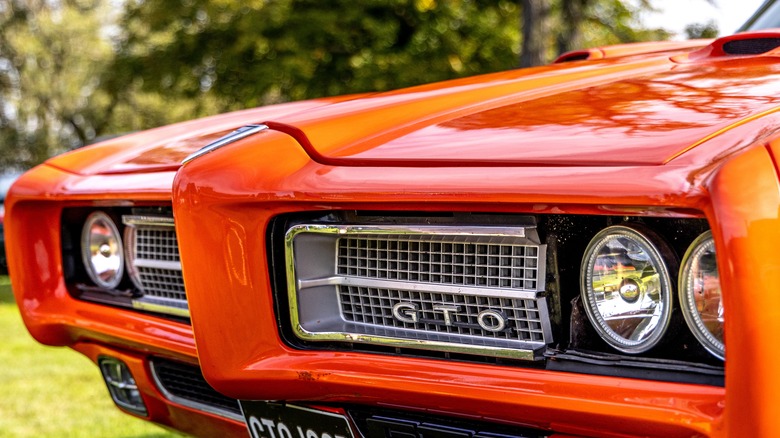
Mareks Perkons/Shutterstock
It is virtually impossible to talk about the American muscle car movement of the 1960s and 1970s without talking about Pontiac and its celebrated GTO build. After all, the almost maniacally souped-up Pontiacs that first wore the GTO moniker are regarded by many as the car that kickstarted all the muscle car madness. As such, they are regularly ranked among the most powerful and revered vehicles to have emerged from the era, and yes, they were pretty easy on the eyes too.
Given their credentials, it’s little surprise that Pontiac GTOs now rank among the most sought-after and expensive Pontiac muscle cars on the vintage automobile market. But even as popular as the cars have become since the GTO first appeared in 1964, there’s one thing that even the biggest fans of the iconic Pontiac build may not know, which is what the three little letters in its name actually stand for.
Letter designations are not uncommon in the automobile arena, and even those who don’t delight in American muscle cars might be quick to tell you that GT typically stands for Grand Touring or Grand Turismo. The latter Italian interpretation is indeed accurate for Pontiac’s GTO. As for the «O,» like Turismo, it is Italian in origin, standing for Omolgato. If you’re wondering why one of America’s best-loved muscle car bears a name sprung from the Italian language, it’s because Pontiac’s GTO may well have taken inspiration from a legendary Italian race car.
Ferrari was the first manufacturer to use the GTO designation

Simlinger/Shutterstock
If you’re familiar with Italian racing outfits from the 1960s, it probably wasn’t hard to guess that the vehicle Pontiac borrowed the GTO designation from was indeed Ferrari’s 250 GTO racer. Enzo Ferrari is widely credited for conjuring the GTO name in the early ’60s, when he and his design team sought to apply it to a line of street-ready vehicles that were also approved for use in certain racing events, hence the inclusion of the word «omolgato,» which translates to «approved» in English.
Of course, in English, the word «homologated» should also stand in for omolgato, as it’s the term most frequently used for road-ready racers in the North American market. As for Ferrari’s 250 GTO, once they started burning up the roadways and raceways of Europe, they instantly became some of the most sought-after vehicles in existence. However, Ferrari had no intention of mass-producing the vehicles. In fact, the company only manufactured 36 cars in the 250 GTO family between 1962 and 1964, and those units were selling for about $18,500 in the ’60s (roughly $189,000 today).
Given their cost and scarcity, few U.S. drivers could actually get their hands on a 250 GTO. Recognizing that market potential, Pontiac set about designing and delivering their own GTO build, which hit the scene bearing a far more buyer-friendly price tag that ranged between $2,500 and $2,800 depending on the trim package. While Pontiac GTOs are likely to cost a pretty penny on resale these days, the super-rare Ferrari 250 GTOs are even more sought after, and have been known to fetch close to $50 million at auction.